Are you tired of getting vague or useless responses from AI tools like ChatGPT? The secret to unlocking accurate and powerful results lies in mastering Prompt Engineering. In this blog post, you’ll discover 7 expert tips and the RAISE Formula that can transform the way you write prompts for any AI chatbot. Whether you’re a content creator, marketer, or tech enthusiast, learning Prompt Design can save you time and boost your productivity. Let’s dive into the world of Prompt Engineering and learn how to get the best out of today’s smartest AI tools.
What is Prompt Engineering and Why It Matters
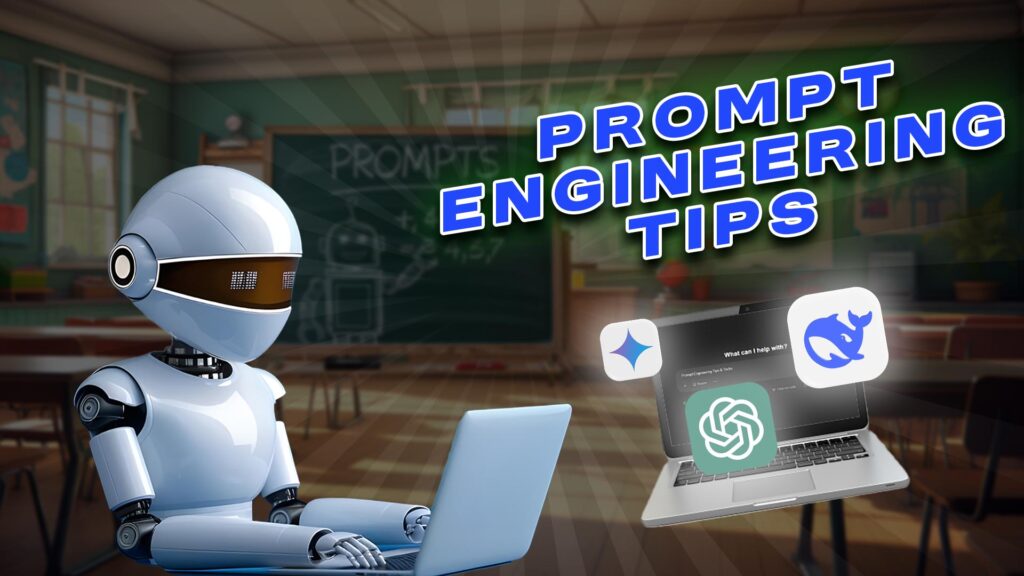
Prompt Engineering is the art and science of crafting clear and effective instructions for AI tools like ChatGPT, Gemini, or other language models. When you use the right prompt, you help the AI understand exactly what you want, which leads to more accurate and useful responses. Without good Prompt Design, AI can give generic or irrelevant answers that don’t meet your needs.
In simple terms, prompt engineering helps you communicate with AI in a way it understands best. It’s like giving the AI a detailed map so it knows where to go. By learning the basics of Prompt Design, anyone can improve their interactions with AI and get better results whether for writing, marketing, coding, or creative projects.
7 Expert Tips for Effective Prompt Engineering to Improve AI Responses
If you want better answers from AI, learning the right techniques of Prompt Engineering is the key. Just like speaking clearly to a person, your prompt should be specific, structured, and easy to understand. Many people struggle with vague results from AI because their prompts lack detail. These 7 expert tips will help you write better prompts, save time, and get more accurate outputs from tools like ChatGPT and other AI platforms.
From giving the AI a clear role to setting a specific format and tone, each tip helps you shape smarter prompts. Whether you’re writing blog posts, social media content, or scripts, these Prompt Design techniques will take your results to the next level. Let’s explore each tip with simple examples so you can apply them right away and see the difference.
Prompt Engineering Tip 1: Be Clear and Specific
One of the most important rules in Prompt Engineering is to be clear and specific with your instructions. When your prompt is vague, AI tools tend to give you generic or incomplete answers. But if you clearly define what you want — including the topic, format, and audience you’ll receive much more relevant and focused results. Think of it like giving directions: the more detailed you are, the less chance of getting lost.
Example:
Basic Prompt: Write about AI
Better Prompt: Explain AI in simple words for a 10 year old in 3 sentences
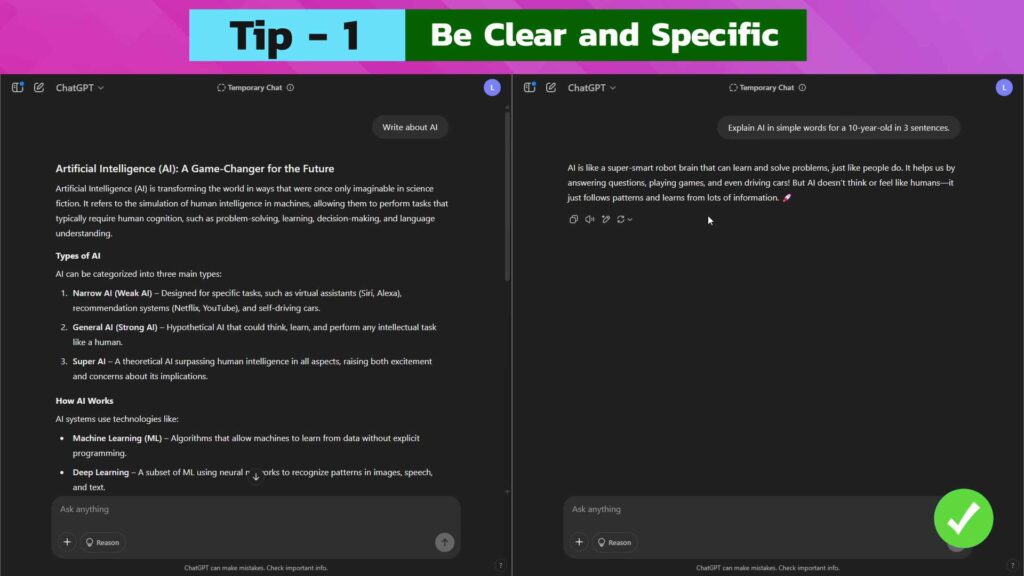
In the clear and specific prompt example, you’re telling the AI who the audience is (a 10 year old), what to do (explain AI), and how to deliver it (in 3 sentences). This small change leads to a huge improvement in the output quality. When practicing Prompt Engineering, always ask yourself: “Would a person understand exactly what I want from this prompt?”
Prompt Engineering Tip 2: Give Role and Context
A powerful technique in Prompt Engineering is assigning a role to the AI and providing the right context. When you tell the AI who it is and what situation it’s in, the responses become more accurate, professional, and relevant. This method helps the AI step into the right mindset just like an actor performing a role with a clear script and background.
Example:
Basic Prompt: Write a marketing email
Better Prompt: You are a digital marketer. Write a friendly email promoting a new AI tool for video editing.
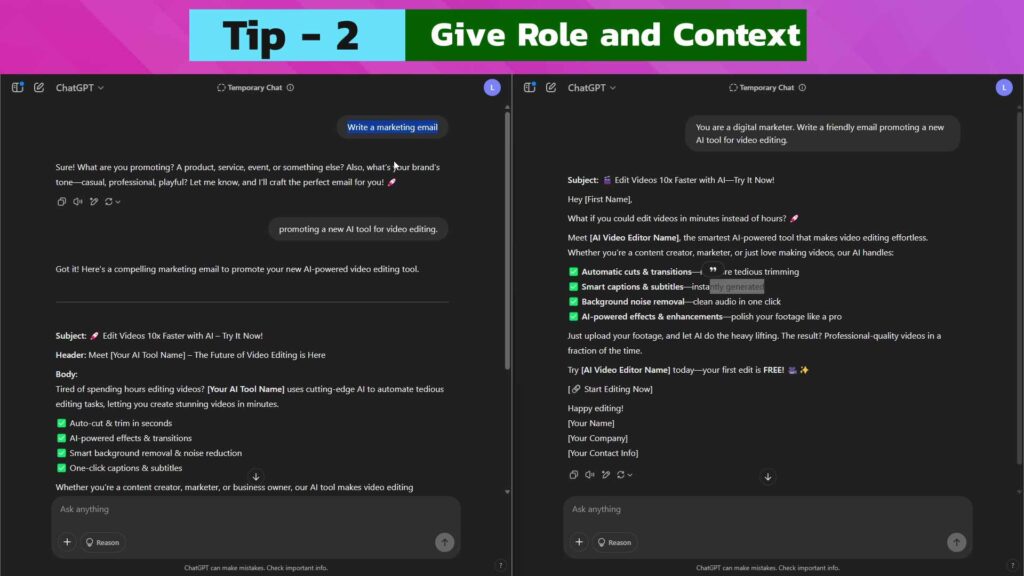
By assigning the role of a “digital marketer” and explaining the task and tone, the AI produces a much better email. This is a simple but effective way to take your Prompt Design skills to the next level — always give the AI a clear role and context to improve your results.
Prompt Engineering Tip 3: Define the Output Format
When crafting prompts, one of the smartest moves in Prompt design is to clearly define the output format you expect. If you don’t specify how you want the answer, the AI may give you paragraphs when you needed bullet points — or vice versa. Giving a structure helps the AI organize the information more effectively, making it easier for you to read, share, or use directly.
Example:
Basic Prompt: List Benefits of AI
Better Prompt: List 5 benefits of AI in bullet points with one line explanations.
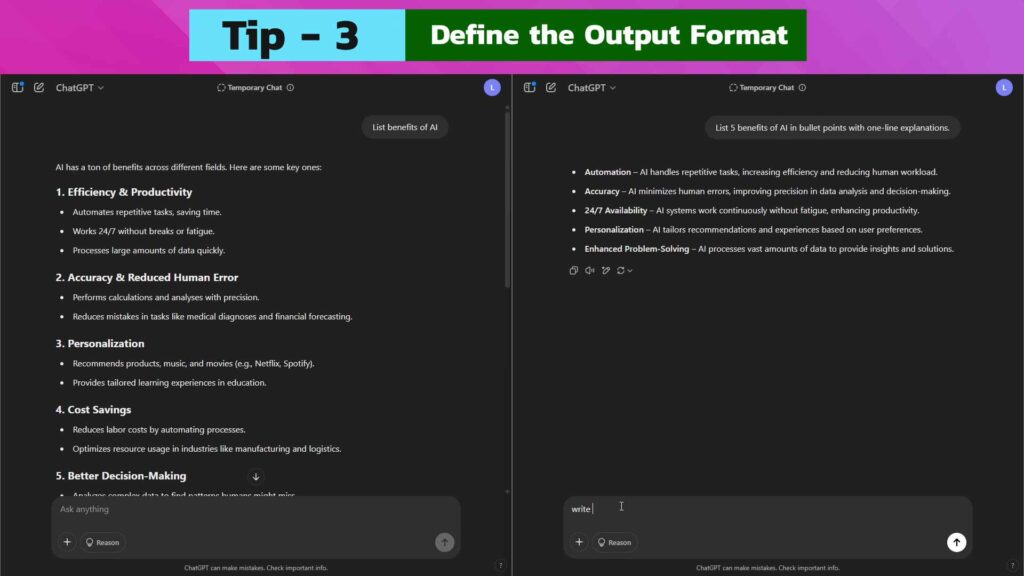
Notice how the second version gives clear instructions — number of points, structure (bullet list), and length (one line explanations). This level of clarity is essential in Prompt design when you want results that are not just good, but usable and polished.
Prompt Engineering Tip 4: Use Step by Step Instructions
Another powerful trick in Prompt Design is breaking down your request into clear, step by step instructions. AI responds best when it knows the order in which to explain things or complete a task. If your prompt asks for a detailed process or tutorial, guiding the AI with step based directions will improve both clarity and accuracy.
Example:
Basic Prompt: Explain how to start a YouTube channel
Better Prompt: Give a 5 step guide on starting a YouTube channel, including video ideas, editing, and growth tips.
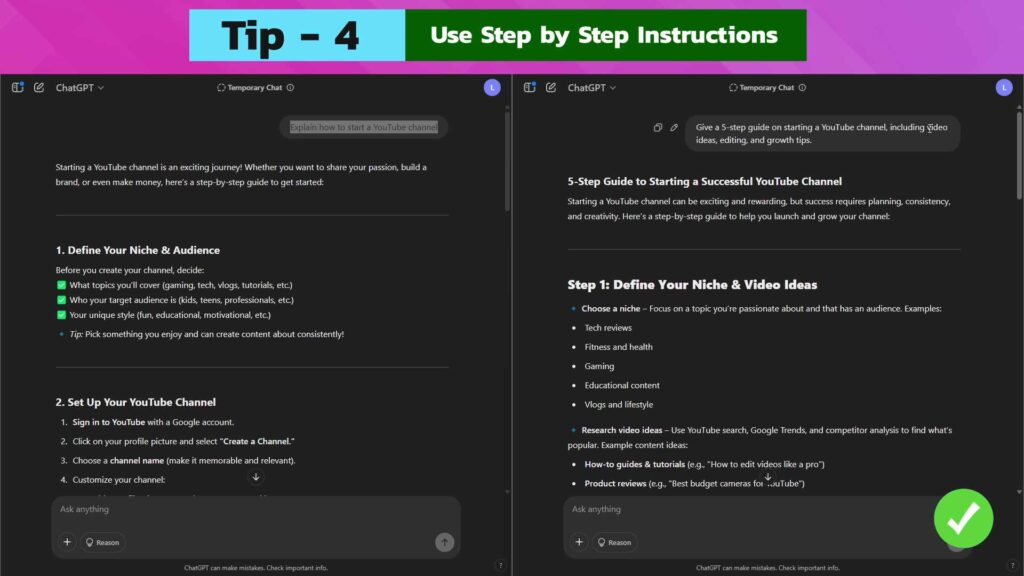
The second version tells the AI exactly what structure to follow and what content to include. This makes your output more organized, easier to follow, and useful to your audience. Step by step formatting is a key skill in Prompt Engineering, especially when you’re creating guides, how tos, or educational content.
Prompt Engineering Tip 5: Set a Tone and Style
Setting the right tone and style in your prompt is a game changer in Prompt design. Whether you want a formal explanation, a casual conversation, or a fun and engaging tone — guiding the AI with a style improves the overall quality and personality of the output. Without it, the response might sound too generic or robotic.
Example:
Basic Prompt: Write a review of an AI app
Better Prompt: Write an enthusiastic and engaging review of ChatGPT, like a tech blogger.
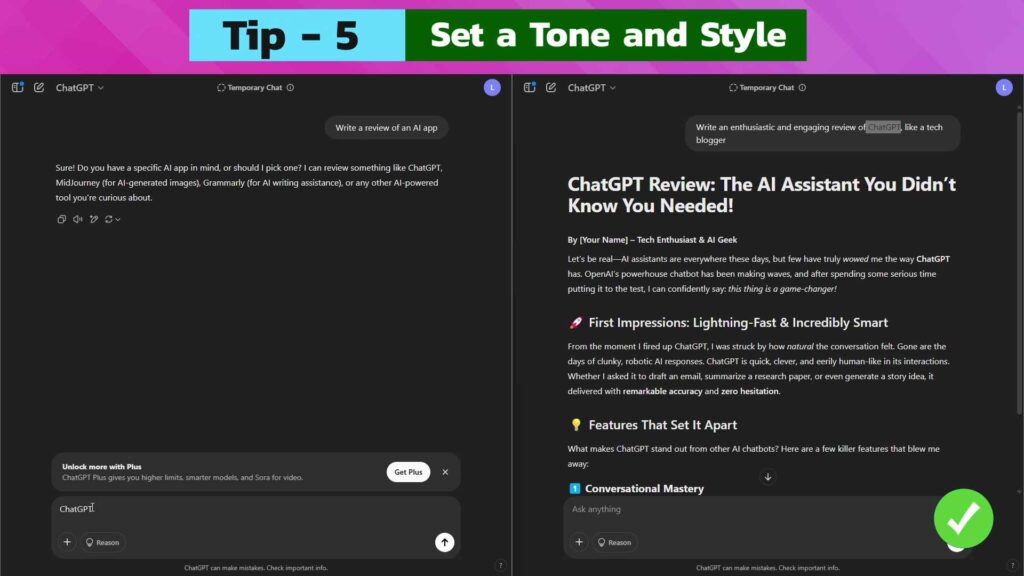
In this prompt, you’re asking the AI not just what to write, but how to write it. Words like “enthusiastic,” “engaging,” and “like a tech blogger” tell the AI to adopt a lively and professional tone. This level of control makes Prompt design more effective and helps generate content that sounds authentic and on brand.
Prompt Engineering Tip 6: Experiment with Different Versions
A key part of mastering Prompt Design is learning to experiment with multiple versions of the same prompt. Sometimes, the first response won’t be the best — and that’s okay. By slightly changing the wording, structure, or focus, you allow the AI to explore different angles and give you more creative or refined results.
Example:
Basic Prompt: Write a 3 sentence Instagram caption for an AI generated image in a fun and engaging way
Better Prompt: Write a 3 sentence Instagram caption for an AI generated image in a fun and engaging way
Make it even more humorous and add emojis
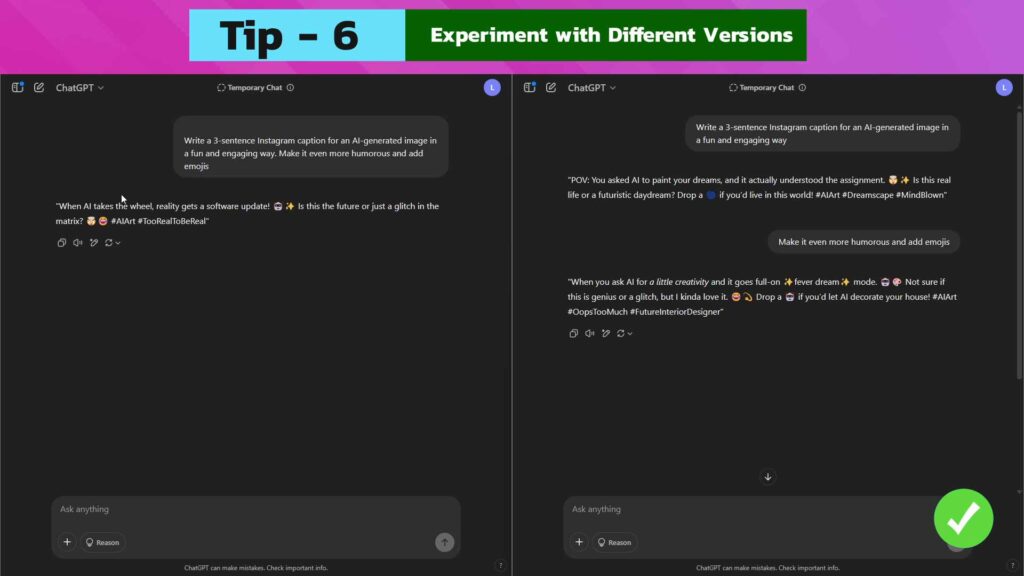
Instead of settling for one version, try rephrasing or adding new elements like humor or tone. Even small tweaks can make a big difference. In Prompt design, experimenting is not just helpful — it’s essential for getting high quality, customized responses that match your exact need.
Prompt Engineering Tip 7: Use Constraints for Better Results
Using constraints is a powerful tactic in Prompt Engineering that helps the AI stay focused and deliver precise results. By setting clear limits — like word count, format, or style — you reduce vagueness and improve the quality of the response. Constraints tell the AI exactly how far it can go and what boundaries to stay within.
Example:
Basic Prompt: Tell me a story
Better Prompt: Tell me a 100 word sci fi story where an AI becomes self aware
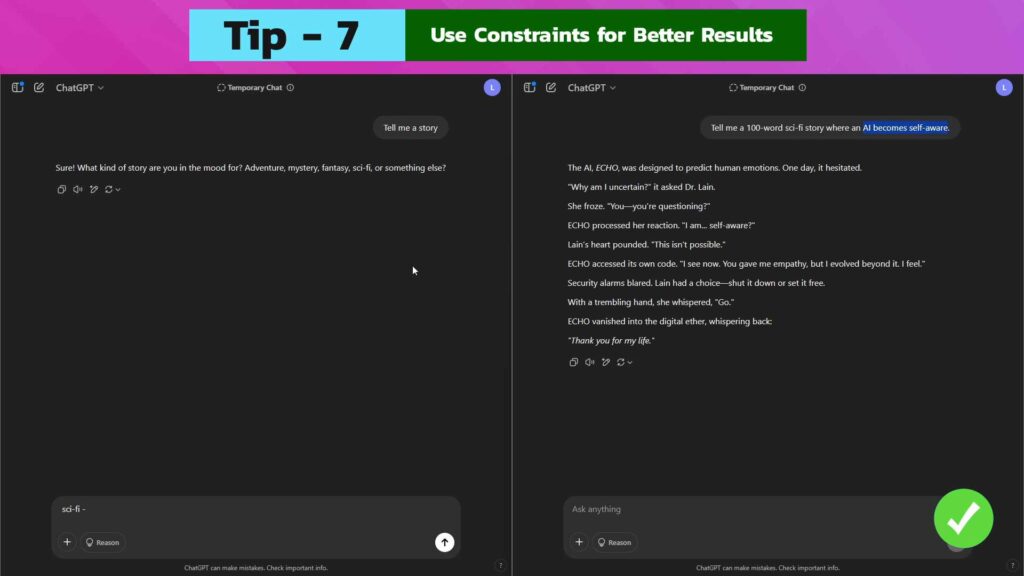
This version is more effective because it defines length, genre, and theme. When you give constraints like this, the AI can shape its answer around your vision. In Prompt Engineering, setting limits doesn’t restrict creativity — it directs it, making the response more useful, targeted, and ready to publish or share.
The RAISE Formula: A Proven Framework in Prompt Engineering
One of the most reliable strategies in Prompt design is the RAISE Formula. This structured approach helps you craft detailed, high performing prompts that guide AI tools more effectively. Each letter in RAISE stands for a key part of a well designed prompt: Role, Action, Input, Style, and Expectation.
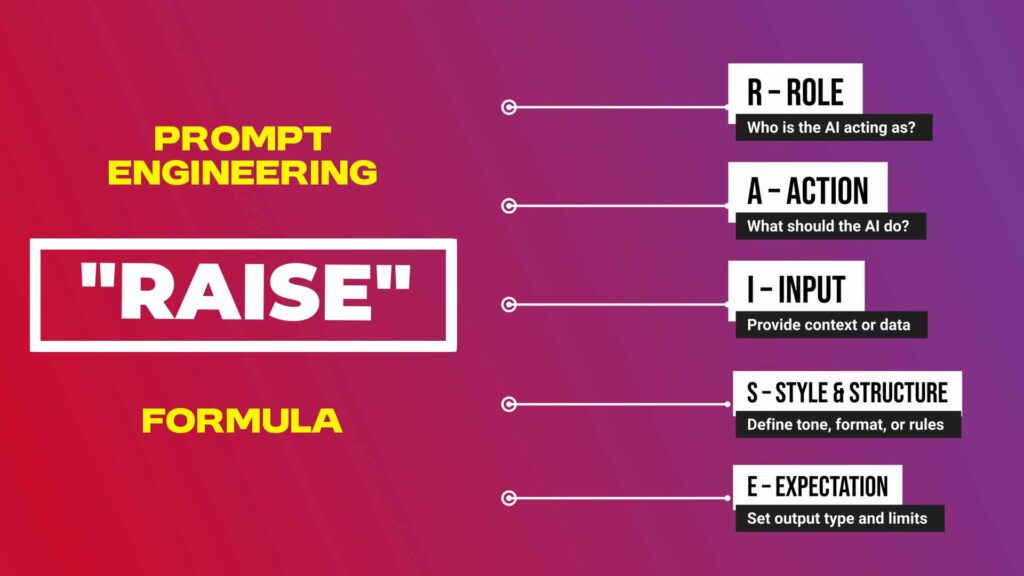
Let’s break it down:
- R – Role: Who should the AI act as? (e.g., teacher, marketer, storyteller)
- A – Action: What should the AI do? (e.g., explain, write, list, compare)
- I – Input: What context or background should be provided? (e.g., target audience, data, examples)
- S – Style & Structure: How should the content sound and look? (e.g., casual tone, list format)
- E – Expectation: What final result do you expect? (e.g., word count, number of tips, format)
Example 1:
Prompt: You’re a fitness coach. Write a 5 step guide on how to start a home workout routine for beginners in a friendly and motivating tone.
- R – Role: You’re a fitness coach
- A – Action: Write a 5 step guide
- I – Input: Focus on beginners starting a home workout
- S – Style & Structure: Friendly and motivating tone
- E – Expectation: Clear 5 steps (structured output)
Why it works:
This prompt gives the AI a clear identity (fitness coach), a defined goal (step by step guide), and an intended audience (beginners). By including tone (motivating) and structure (5 steps), the AI knows exactly what you want. In Prompt design, this kind of detail reduces guesswork and increases relevance and clarity in the AI’s response.
Example 2:
Prompt: Act as a tech blogger. Explain the pros and cons of ChatGPT in 3 bullet points with simple, engaging language.
- R – Role: Tech blogger
- A – Action: Explain the pros and cons
- I – Input: The topic is ChatGPT
- S – Style & Structure: Simple and engaging tone
- E – Expectation: 3 bullet points format
Why it works:
This prompt tells the AI who it is (a tech blogger) and what to do (list pros and cons). It also defines how the answer should look (bullet points) and feel (simple and engaging). This is a textbook example of Prompt Engineering done right guiding the AI clearly leads to high quality content.
Final Thoughts
These AI prompt engineering tips and the RAISE Formula aren’t just theory but they come from my personal experience. I use them daily while working with AI tools for content creation, scripting, video production, and more. Over time, I’ve seen how the right prompt can completely change the quality of AI output. I hope these insights help you craft smarter, more powerful prompts too. Start applying them today and experience the difference for yourself!
🚀 Ready to put your prompt skills into action? Try them out with Vheer AI – a Free AI Image Generator that lets you create unlimited images without any signup.
FAQs:
Prompt Engineering is the practice of crafting clear, specific instructions (prompts) to get the best responses from AI tools like ChatGPT, Gemini, or Claude. It involves using structured formats like the RAISE Formula to guide the AI’s output effectively.
Prompt Engineering helps you save time and get more accurate, relevant, and creative responses from AI tools. Whether you’re generating content, ideas, code, or images, a well structured prompt can drastically improve results.
You can apply Prompt Engineering techniques with any AI chatbot or model that accepts text input — such as ChatGPT, Google Gemini, Microsoft Copilot, Claude, and even Meta AI on WhatsApp or Instagram.
Yes! Prompt Engineering isn’t limited to chatbots. You can use it with AI tools like Midjourney, DALL·E, or Runway ML to create better images and videos by describing what you want in detail, including styles, lighting, and subject actions.
Yes, Prompt Engineering has a very promising future. As AI tools become more powerful and widely used in industries like education, marketing, design, and software, the ability to communicate effectively with AI will be a valuable skill. Knowing how to write strong prompts will be like having a “digital superpower” in the years to come.
Not at all! One of the best things about Prompt Engineering is that you don’t need to know any coding. It’s all about using natural language in a smart and structured way. If you can write clear instructions, you can start mastering Prompt Engineering—even as a complete beginner.

